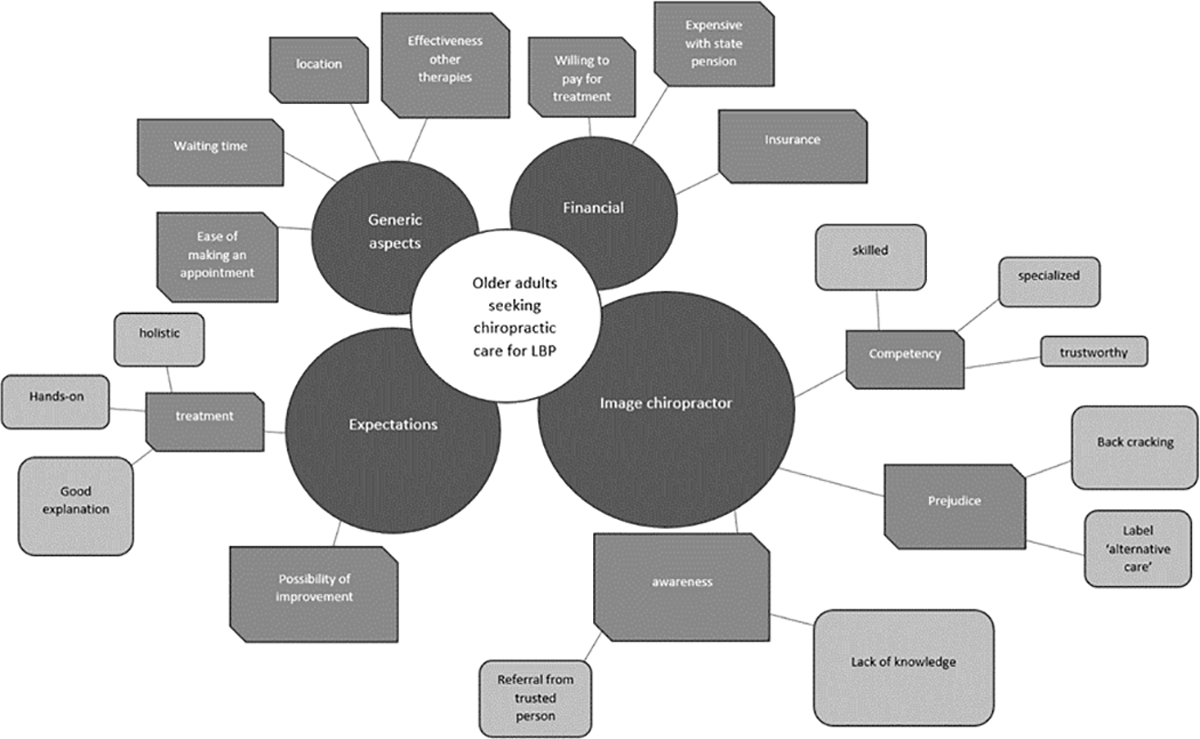The Perceived Barriers and Facilitators for Chiropractic Care in Older Adults with Low Back Pain; Insights from a Qualitative Exploration in a Dutch Context
SOURCE: PLoS One 2023 (Apr 12); 18 (4): e0283661
| OPEN ACCESS |
Lobke P. De la Ruelle, Annemarie de Zoete, Cornelius Myburgh, Hella E. Brandt, Sidney M. Rubinstein
Department of Health Sciences,
Faculty of Science,
Amsterdam Movement Sciences,
Vrije Universiteit Amsterdam,
Amsterdam, The Netherlands.

Background: Understanding care seeking behaviour is vital to enabling access to care. In the context of low back pain (LBP), chiropractors offer services to patients of all ages. Currently, geriatric sub-populations tend to be under-investigated, despite the disproportionate effects of LBP on older adults. In the Netherlands, the chiropractic profession is relatively unknown and therefore, generally speaking, is not considered as the first choice for conservative musculoskeletal primary health care. The aim of this paper was to explore the experiences of older adults with LBP, seeking chiropracic care for the first time, in order to identify perceived barriers and facilitators in this process.
Methods: Stage 1: Participants 56 years of age and older with chronic LBP who either sought or did not seek chiropractic care were interviewed to provide detailed information on the factors that promoted or impeded care-seeking behaviour. A purposive sampling strategy was used to recruit participants through a network of researchers, chiropractors and other healthcare professionals offering musculoskeletal health care services. Individuals with underlying pathology, previous surgery for LBP, or insufficient mastery of the Dutch language were excluded. Data were collected until saturation was reached and thematically analysed. Stage 2: To further explore the themes, a focus group interview was conducted with a provider stakeholder group consisting of:two physiotherapists, a nurse practitioner, a geriatrician, and a chiropractor. All interviews were conducted online, voice recorded, and transcribed verbatim.
There is more like this @ our:
MEDICARE Section and the:
Results: We interviewed 11 older adults with low back pain. During this process four themes emerged that captured their perception and experiences in either seeking or dismissing chiropractic care for their LBP; these being ‘generic’, ‘financial’, ‘expectation’, and ‘the image of the chiropractor’. The focus group members largely confirmed the identified themes, highlighting a lack of awarenes and accessibility as key barriers to care. On the other hand, whe chiropractior as an alternative care provider, with a focus on manual interventions, was seen as a facilitator.
Conclusions: The lack of knowledge about chiropractic care was found to be the most important barrier to seeking care. The most important facilitator was insufficient resolution of their symptoms following previous care, making patients look further for a solution for their problem. These barriers and facilitators seem not to differ greatly from barriers and facilitators found among younger patients with neck pain. Age and health condition may therefore be weak determinants of care. This new information may help us optimize accessibility for older adults to the chiropractor.
Subject Areas: Chiropracticn Elderly, Pain, Lower back pain,
Finance, Qualitative studies, Surgical pathology
From the FULL TEXT Article:
Introduction
Low back pain (LBP) is a highly prevalent musculoskeletal complaint in western countries, which is associated with substantial costs. [1] Given the aging population in the Netherlands, these figures are only likely to increase in the coming years. In comparison to their younger counterparts, LBP may have a disproportional effects on older adults due to a decreased mobility resulting in limited social participation and a greater chance of isolation, and reduced perceived quality of life. [2, 3] However, data is currently severely lacking in this sub-population.
In the Netherlands, chiropractic care is considered ‘alternative care’. For the Dutch LBP patients this means that health care insurance only covers some, but never 100% of the costs. The profession is relatively small with only 571 practitioners in a country with more than 17 million inhabitants. Despite their small numbers, in 2019 more than 1 million treatments were delivered by chiropractors (unpublished observations) in the Netherlands. All chiropractors working in the Netherlands are trained abroad, as there is no chiropractic college in the country.





Leave A Comment